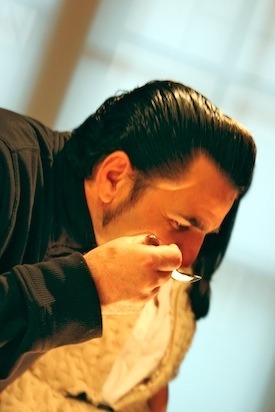The Art Of Tasting Coffee: Cupping 101
We may receive a commission on purchases made from links.
Agitate and breath in the aroma of the liquid. Then take a sip—evaluating the mouthfeel, identifying its notable flavor characteristics—and spit. No, it's not wine you're tasting, but coffee. Reffered to as "cupping" in industry lingo, we recently spoke with Kobricks Coffee Roastmaster Mike Calabrese to learn what the technique is all about.
Where does the term "cupping" come from?
We were discussing this, looking at Uker's [All About Coffee by William H. Ukers] book, the coffee bible from aeons ago, and it has to do with the cups we use to test the coffee in. For each varietal that we're testing we try to put out five or six cups to judge. Traditionally, and when Kobricks started, porcelain cups were used—almost like little dessert cups—which are ideal for heat retention. Now we use glass, which is a good alternative.
Walk us through the cupping process.
Pour the hot water, say around 200 degrees, over the sample. Rather than a traditional brew, it's a coarser grind and a lighter roast. It's like steeping tea, the hot water allows for that extraction. The grinds rise to the top and form a crust. Wait a minute, and then break it—that's when you really release all the aroma. Take a sip without burning your nose (although any cupper worth their salt has burnt their nose a couple of times). It's about getting the spoon to the bottom of the cup, agitating the grinds and stirring upwards. They disperse down and that releases all the aroma. We have a Fair Trade Ethiopian lot, it has a sensation like lemon Pledge, just this amazing bouquet and explosion of aroma. With the unwashed Harrar, it smells like blueberry muffins when you break the crust.
Why is a light roast and coarse grind so important?
With a lighter roast and a coarser grind, you're retaining more of the organic compound, it's in its most naked state. When you're cupping for evaluation, you're looking to see if there are any defects. The longer and darker you roast, the more you mute the defects, as well as the better notes.
Baggy?
Baggy, it's a colloquialism. Usually it refers to lots that have been sitting in harbor for a while, and sometimes will have water damage. The beans smell like the bags they've been sitting in.
What's up with the "quick slurp" technique?
The purpose is to spray the coffee across the tongue—front to side to back. You pretty much have your teeth clenched so that the liquid hits the tongue evenly. Also, you're looking to get a sense of the body and the mouthfeel. Spray it in, let it coat the tongue, and then spit it out immediately. It's so lightly roasted, and very acidic, with a very high caffeine content—it's not the most pleasant to swallow.
Can you still cup once the sample has cooled a little?
As it cools down it actually starts to shine a little more. The reason you need hot water is to get the proper extraction. It really depends on the person, some like hot, other like it colder or more tepid. That's why you always go back and taste a few times, you won't make a judgement on one taste alone.
Wet vs. dry, natural vs. semi-washed. How does process affect the flavor?
Dry: Deeper in body, with a tendency to be sweeter.
Wet: Cleaner, more fruity.
Natural: Kind of wild, but tends to be sweeter as well.
Semi-washed: Also kind of fruity, maybe with slight mocha and chocolate notes.
What characteristics and flavors can one look for in the major varieties?
With the Central and South Americans, what we're looking for is sweetness and acidity, mild to full body and an even mouthfeel. Costa Rica has some buttery tones. Africans, like the fair trade Ethiopian, tend to be citrusy and fruity, very pronounced. Kenya is full-bodied, with a winey, nutty note, it's one of the best to cup. Sumatras have low to almost no acid, earthy, with nice body. Indian Monsoon Malalbar has a star anise flavor, Yemen Mocha has malted chocolate overtones.
What three varieties are you particularly excited about right now?
1. Lake Tawar Sumatra: Earthy, with notes of wheat and fig.
2. Fair Trade Ethiopian Yirgacheffe: Everytime I cup it it has amazing citrus notes, so spicy and delicious.
3. Rainforest Alliance Certified Guatemala: Huehuetenango: Sharp, bright, sweet acidity.
Because it has to be asked, how do you take your coffee?
Totally black. As black as I can stand it. I don't think I've had a cup with cream and sugar since the late Eighties. I like to sip it hot, I start to slurp like I'm cupping it. At this point, it's almost like a reflex.
